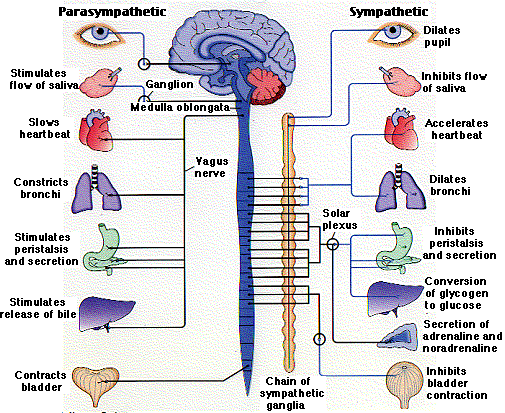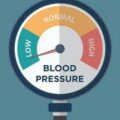What is the Autonomic Nervous System?
The autonomic nervous system is that part of the nervous system responsible for the control of the bodily functions not consciously directed, examples of these functions include breathing, heartbeat, and digestive processes of the body. The autonomic nervous system is regulated by the hypothalamus.
What is included in the autonomic nervous system?
The autonomic nervous system is the component of the nervous system that supplies the internal organs, including the blood vessels, stomach, intestine, liver, kidneys, bladder, genitals, lungs, pupils, heart, and sweat, salivary, and digestive glands. The autonomic nervous system can be subdivided into the parasympathetic nervous system (PSNS) and the sympathetic nervous system (SNS). These two divisions have antagonistic (opposing) effects on the internal organs they innervate (send nerves to = act on).
What is the difference between somatic and autonomic nervous systems?
The somatic nervous system (SoNS) is the part of the peripheral nervous system associated with the voluntary control of body movements through the skeletal muscles and mediation of involuntary reflex arcs while the autonomic nervous system is the part of the nervous system which controls functions not consciously directed, such as breathing, the heartbeat, and digestive processes.
What happens if the autonomic nervous system is damaged?
Autonomic neuropathy is a type of damage to the autonomic nervous system is which occurs when the nerves that control involuntary bodily functions are damaged. Injury to the nerve interferes with the messages sent between the brain and other organs and areas of the autonomic nervous system, such as the heart, blood vessels, and sweat glands.
What is the role of the autonomic nervous system in emotion?
An emotion is a feeling such as happiness, love, fear, anger, or hatred, which can be caused by the situation that you are in or the people you are with. The autonomic nervous system is regulated by the hypothalamus and controls processes as pulse, blood pressure, breathing, and arousal in response to emotional circumstances. The sympathetic nervous system also functions like a gas pedal in a car. It triggers the fight-or-flight response, providing the body with a burst of energy so that it can respond to perceived dangers.
What is autonomic failure?
Pure autonomic failure (PAF) refers to a peripheral degenerative disorder of the autonomic nervous system. Symptoms include Orthostatic hypotension (fall in blood pressure with standing) and impotence (inability to have or maintain an erection).
What are the symptoms of autonomic dysfunction?
Diabetes and Parkinson’s disease are two examples of chronic conditions that can lead to autonomic dysfunction. The symptoms of autonomic nervous system dysfunction include
- Exercise intolerance due to inability to alter heart rate with exercise
- Dizziness and fainting upon standing up
- Sweating abnormalities ( sweating too much or not sweating enough)
How does Parkinson’s disease affect the autonomic nervous system?
Autonomic nervous system dysfunction in Parkinson’s disease may be caused by an underlying degenerative process that affects the autonomic ganglia, brainstem nuclei, and hypothalamic nuclei. Medications used in treating Parkinson’s disease can also cause or worsen symptoms of Autonomic nervous system dysfunction.
Is there a cure for Autonomic Dysfunction?
Treatment of autonomic nervous system disorders such as autonomic nephropathy involves managing the disease or condition damaging your nerves. Many autonomic nervous system disorders get better when the underlying disease is treated. However, the major goal of treatment is to improve symptoms as there is no cure.
How do you treat autonomic Neuropathy?
To treat heart and blood pressure symptoms:
- Take a medicine that raises your blood pressure.
- Take medicine to control your heart rate.
- Stand up slowly so you don’t get dizzy.
- Get extra salt and fluid in your diet to help raise your blood pressure.
How do you calm the autonomic nervous system?
You can calm the autonomic nervous system by stimulating the parasympathetic nervous system component of the ANS to restore the lost balance. The following techniques for stimulating the parasympathetic nervous system to calm the autonomic nervous system were adapted from Rick Hanson’s excellent book, Buddha’s Brain. You can try these just about anywhere, anytime.
Breathe from your diaphragm — This stimulates the parasympathetic nervous system because it slows down your breathing. If you put your hand on your stomach and it rises up and down slightly as you breathe, you know you’re diaphragm breathing
Combine diaphragm breathing with mindfulness — The practice of calmly resting your attention on whatever is happening in the present moment. If your sympathetic nervous system is in a constant state of arousal, mindfulness helps restore the proper balance between the sympathetic and parasympathetic systems by increasing the activity of the latter. This creates a feeling of calm and relaxation.
A favorite of mine — Lightly run one or two fingers over your lips— Parasympathetic fibers are spread throughout your lips so touching them stimulates the parasympathetic nervous system. I was skeptical of this until I tried it. Now it’s my “go to” practice for immediately calming my mind and body. Once I’m calm, I slow down naturally.
Use imagery to stimulate the parasympathetic nervous system — visualize yourself in a peaceful place, like a mountain stream, a forest, a secluded beach. Engage all your senses in this imagery—sights, sounds, the feel of the breeze on your face.





